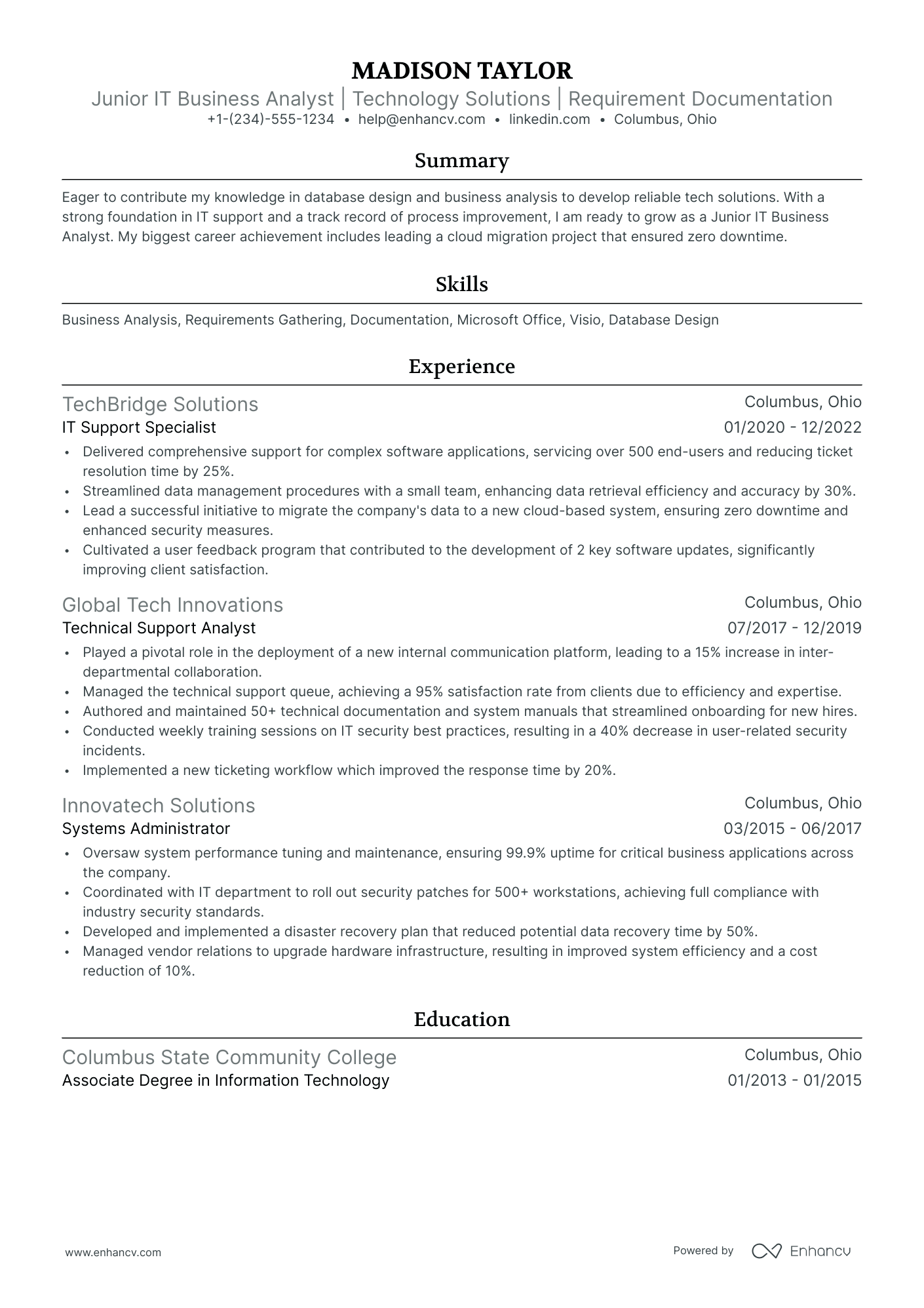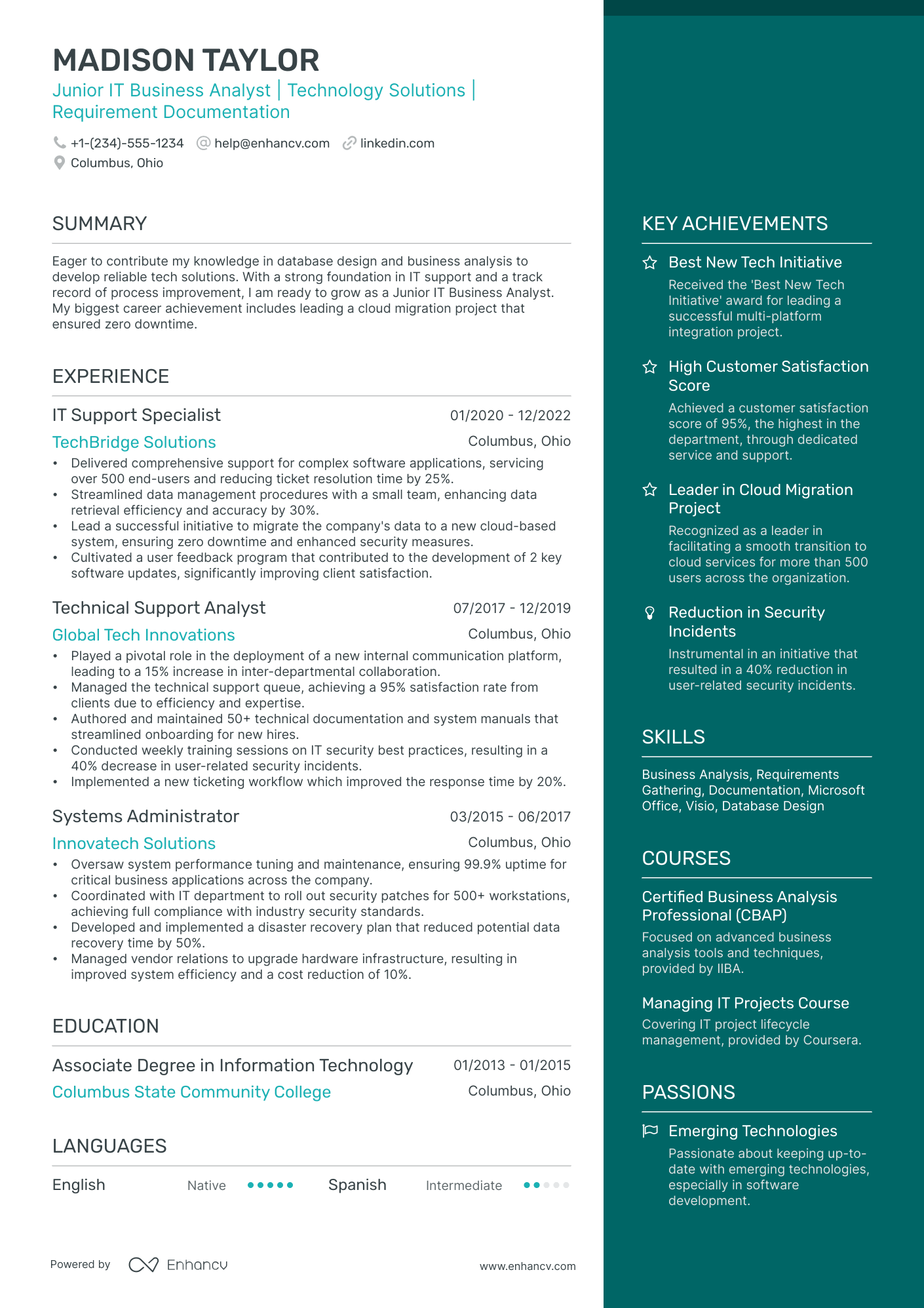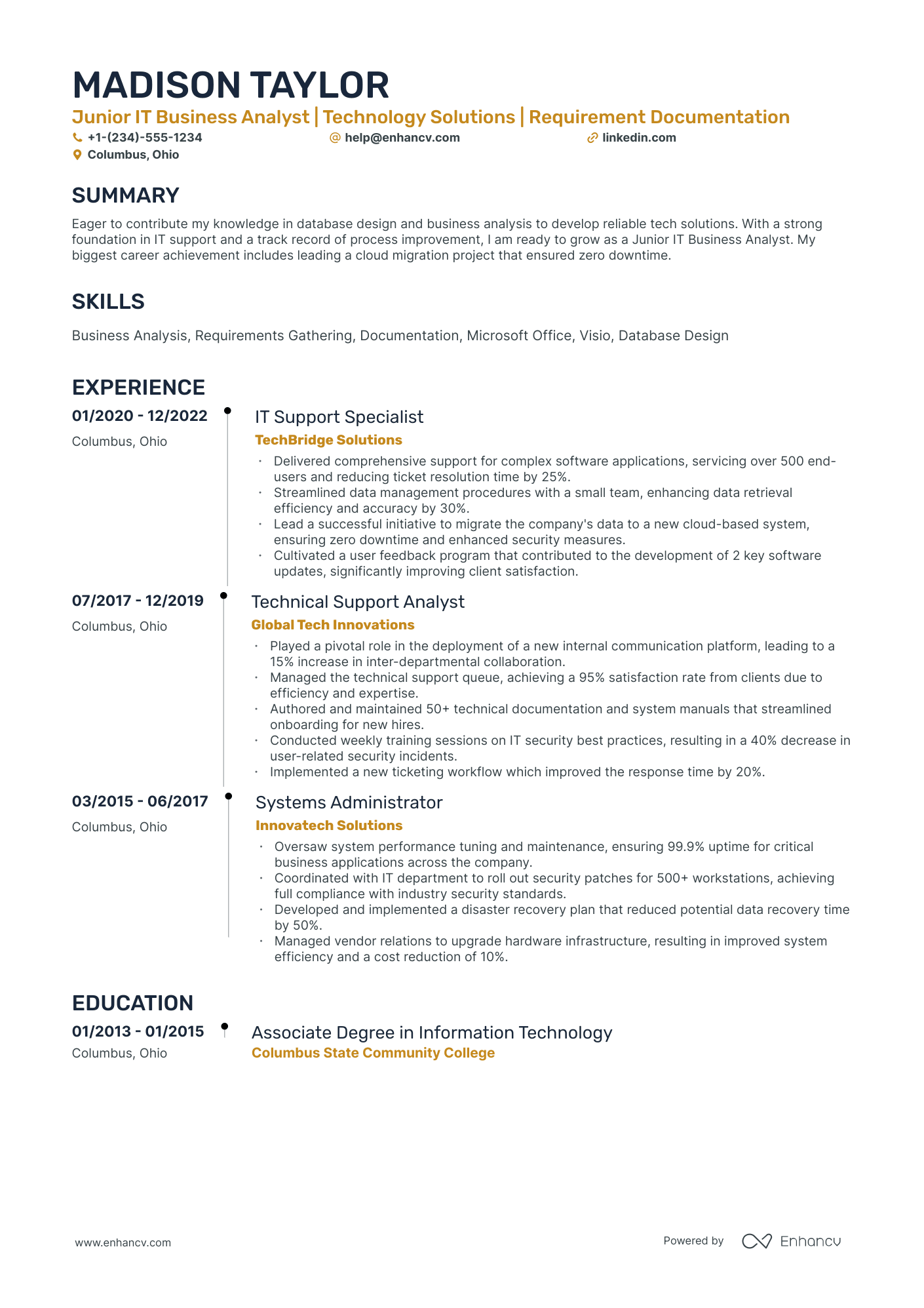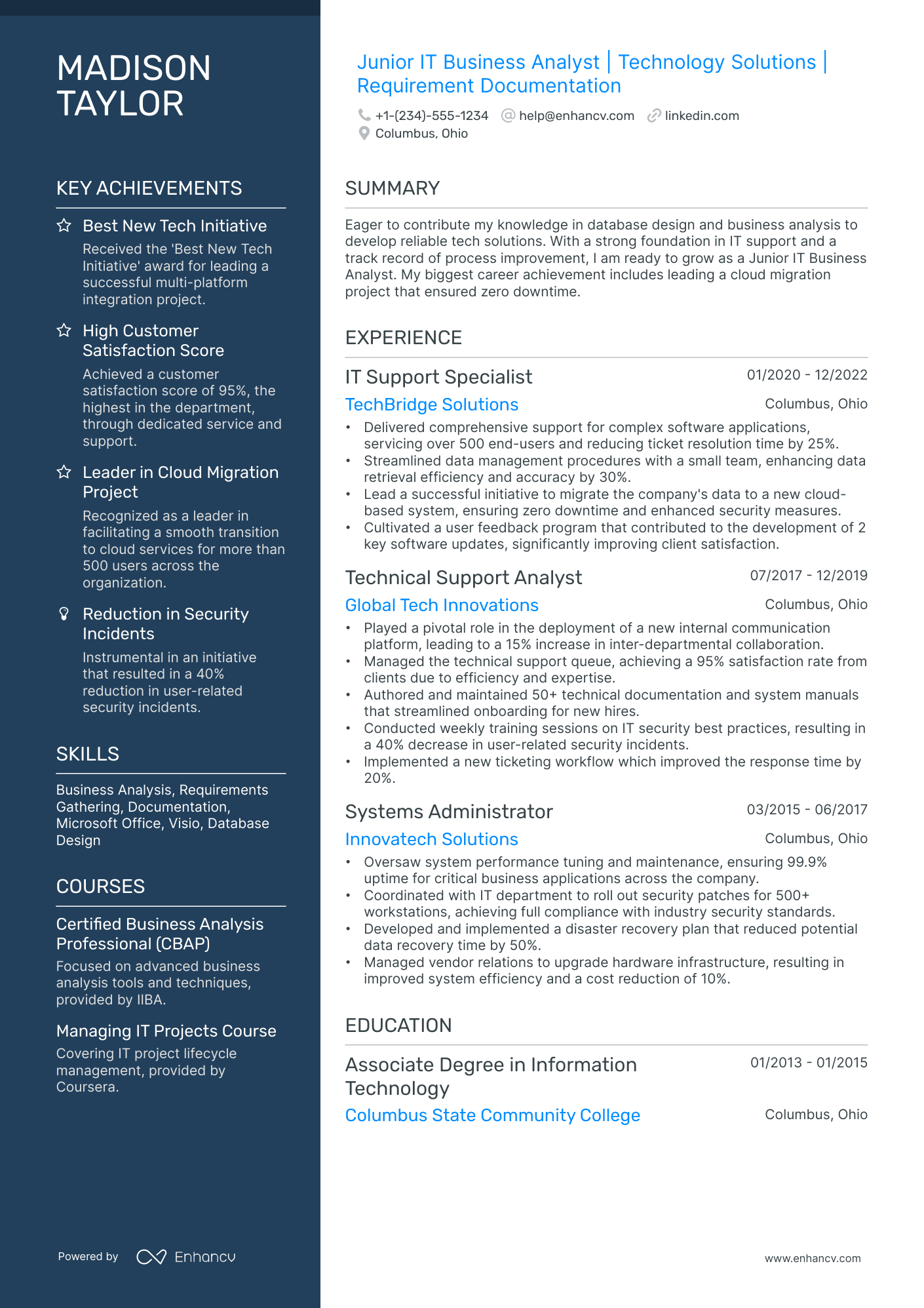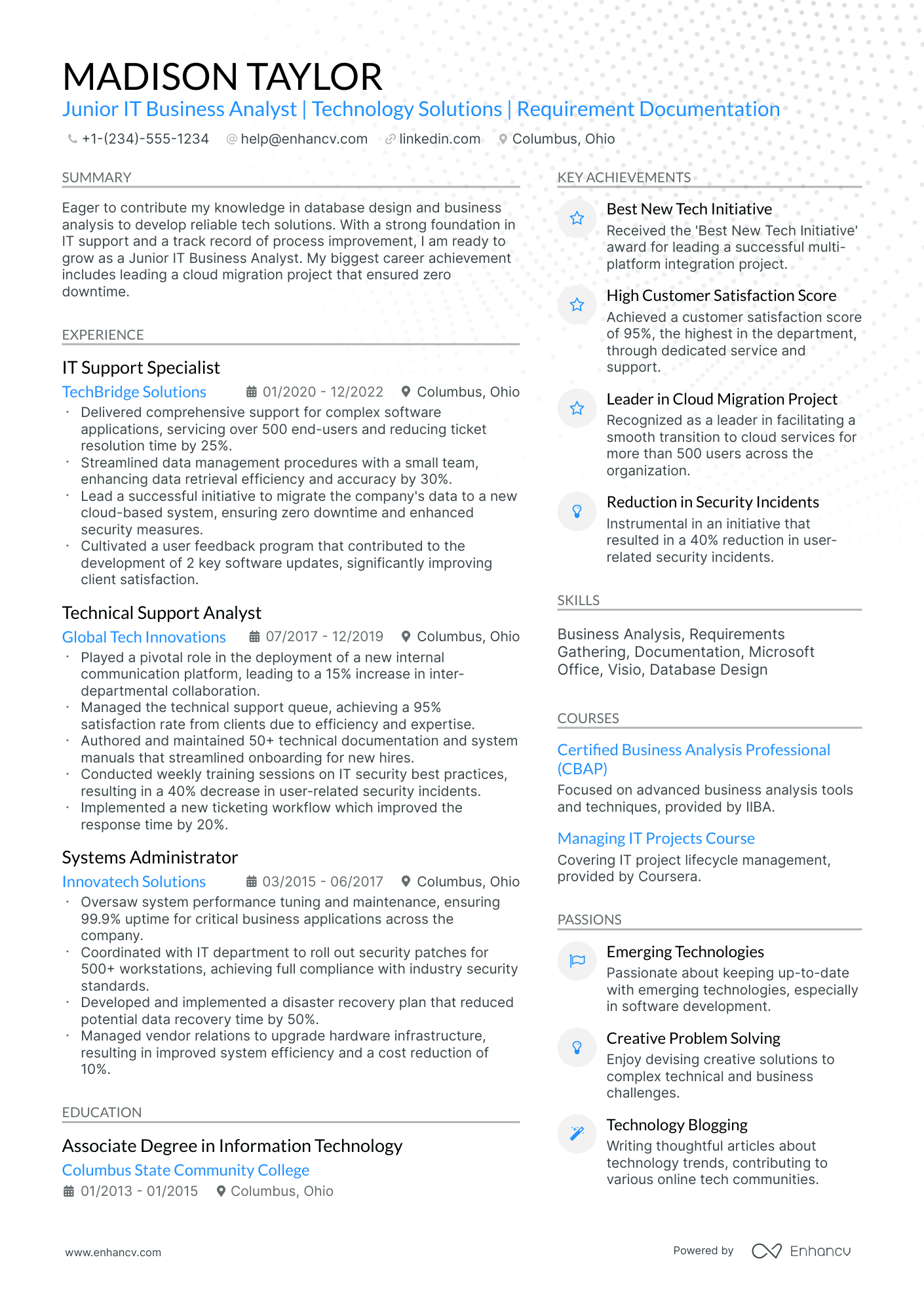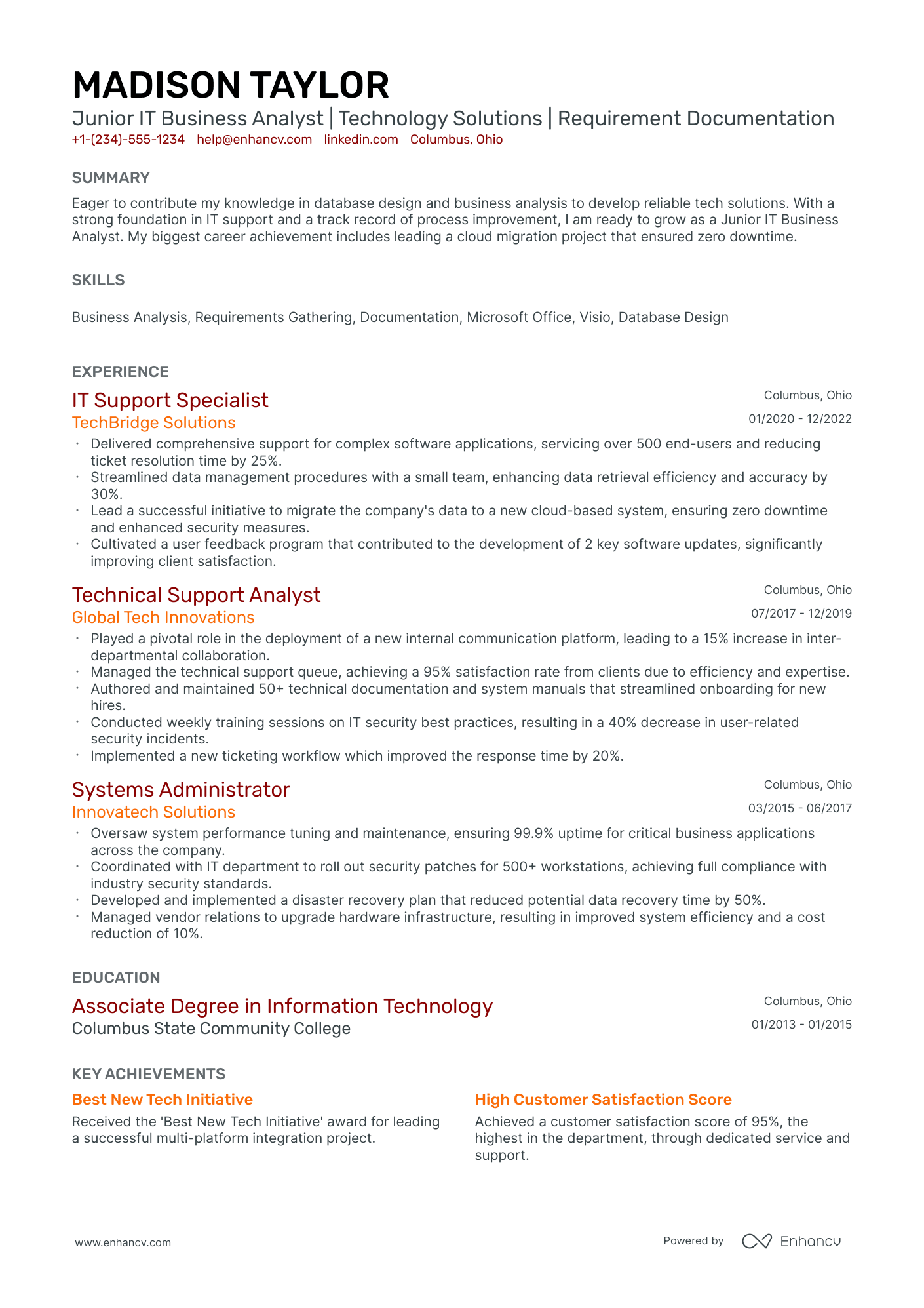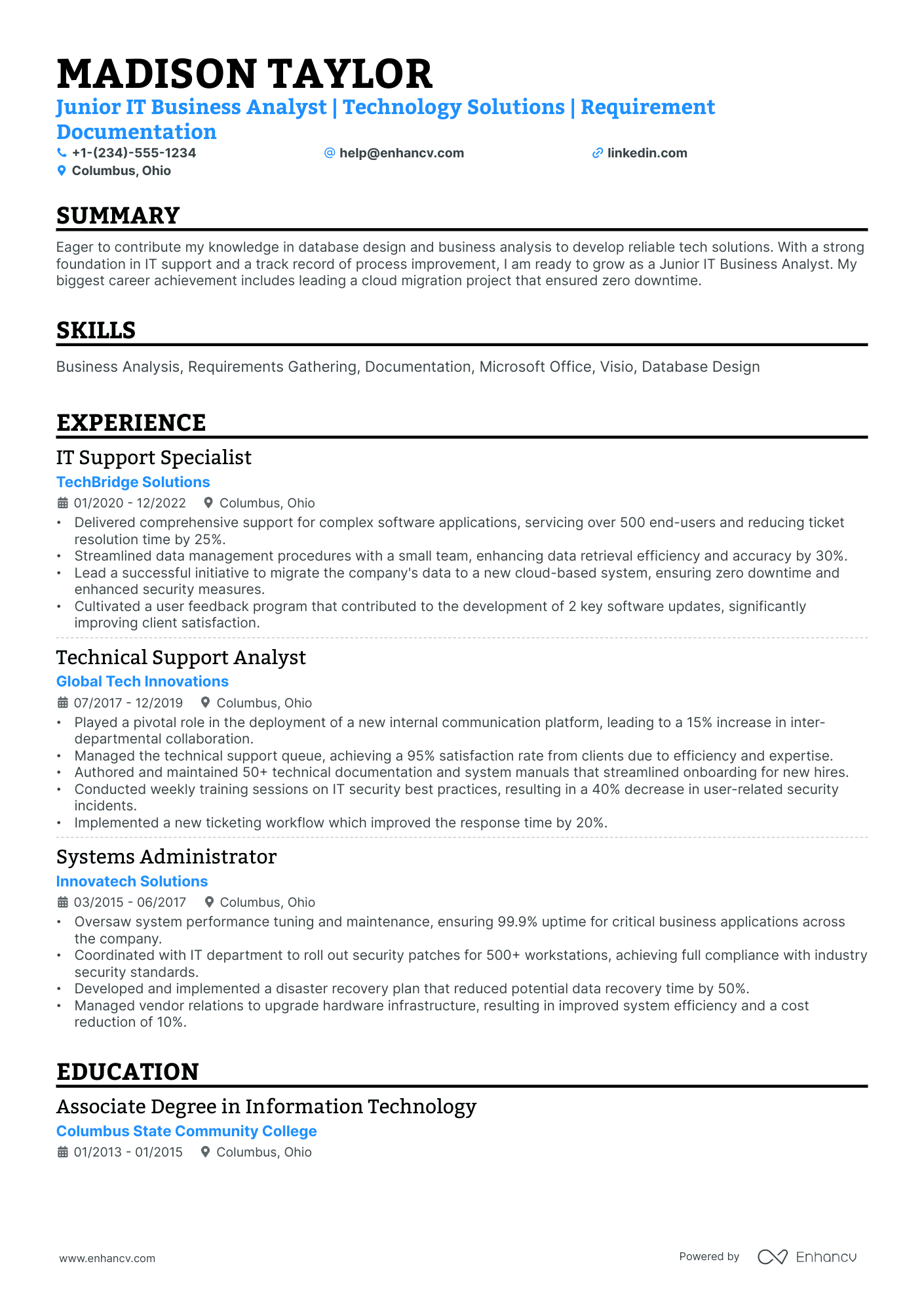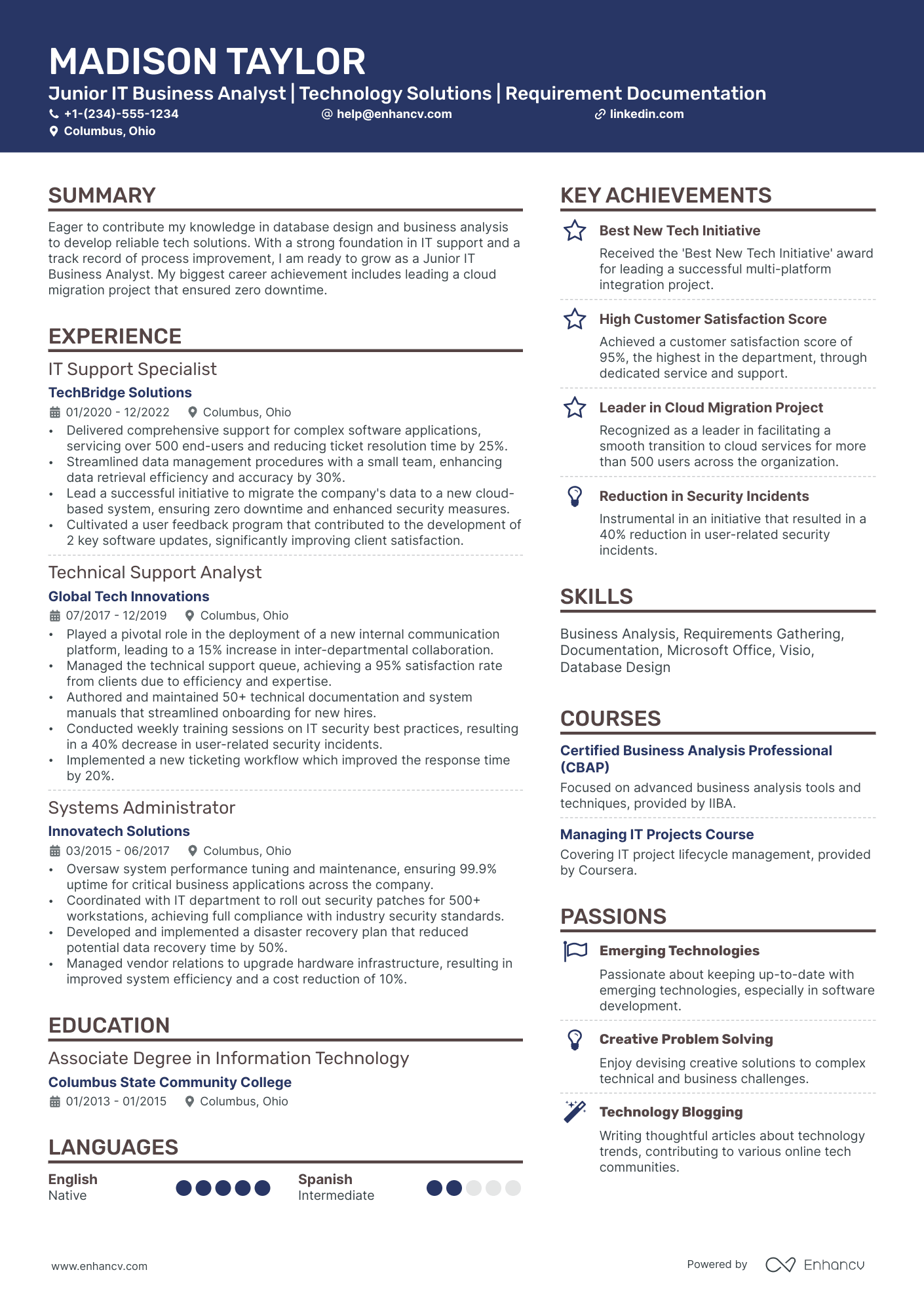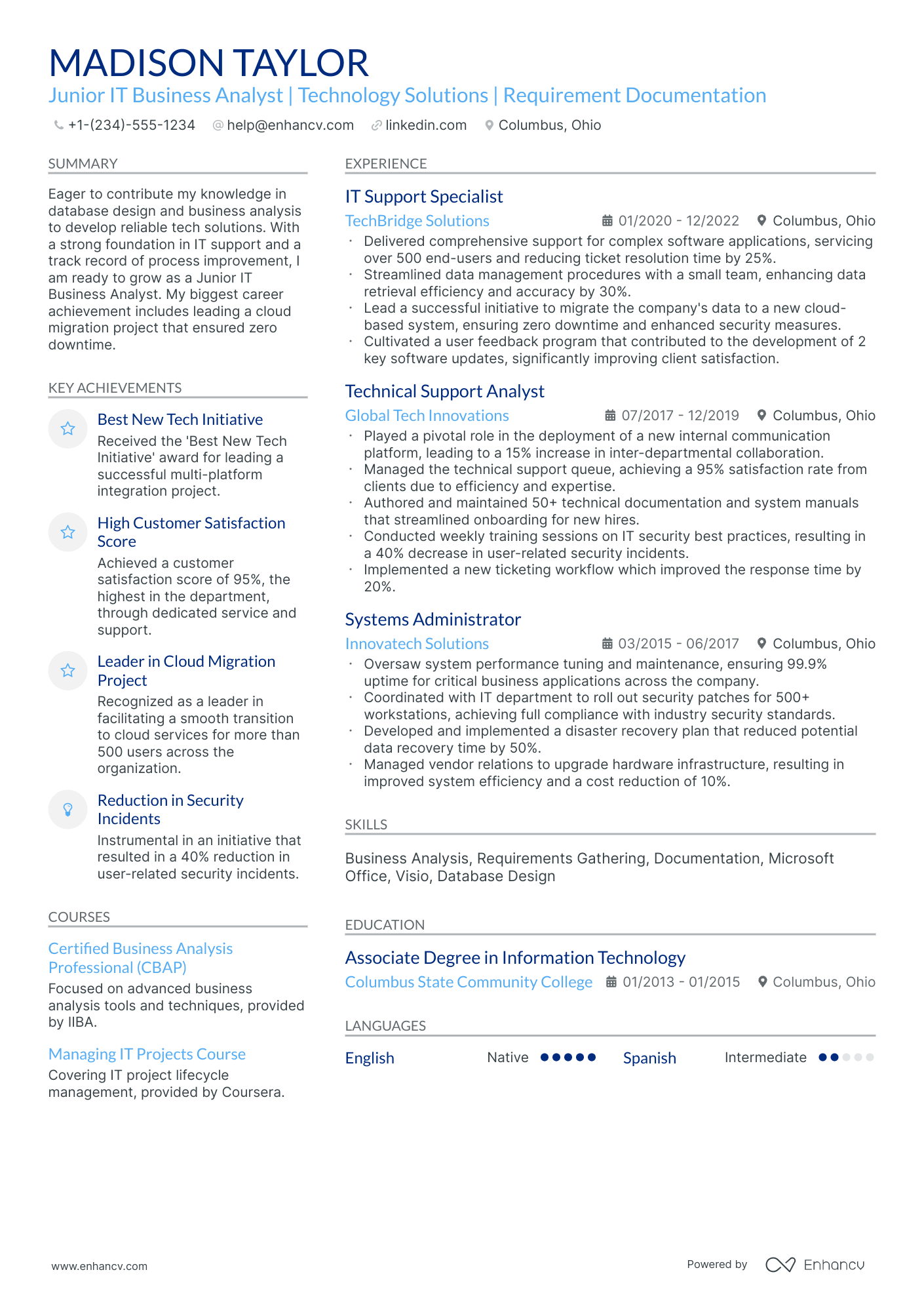One challenge you may face as an IT business analyst is effectively showcasing your ability to translate complex data into actionable business insights on your resume. Our guide provides targeted advice and examples to help you highlight your analytical prowess, ensuring your resume stands out to potential employers.
- IT business analyst resume samples that got people hired at top companies.
- How to perfect the look-and-feel of your resume layout.
- How to showcase your achievements and skills through various resume sections.
- How you could hint to recruiters why your resume is the ideal profile for the job.
If the IT business analyst resume isn't the right one for you, take a look at other related guides we have:
- Banking Business Analyst Resume Example
- Configuration Manager Resume Example
- Alliance Manager Resume Example
- Safety Manager Resume Example
- Service Delivery Manager Resume Example
- Sourcing Manager Resume Example
- SAP Business Analyst Resume Example
- Club Manager Resume Example
- Resource Manager Resume Example
Is there a correct way to format your IT business analyst resume?
This is a tricky question. While skimming over your resume, recruiters will be looking at your experience and the message your profile conveys. That's why your resume format needs to be clear and concise, serving to supplement and organize your experience. Professional best practices point that the best IT business analyst resumes:
- Follow the reverse chronological order, where the most recent experience items are presented first . This is to keep your expertise succinct and to show recruiters your career growth over the years;
- Have a clearly defined header that includes all relevant contact information and a portfolio or a LinkedIn link. In some countries, it is acceptable to include a professional photo , so that your application is more memorable;
- Feature the most important IT business analyst resume sections towards the top, e.g. summary, skills, and experience. That way, recruiters can immediately find information that is relevant to the role;
- Take up no more than two pages - and two pages are the exception for more experienced professionals. Keep your expertise to the point and use your IT business analyst resume real estate wisely .
- Selecting modern, yet simple fonts, e.g. Rubik, Lato, etc., would help your application stand out;
- Many candidates stick with the tried-and-tested Arial or Times New Roman, but you'd want your IT business analyst resume to be a bit more unique;
- The ATS can read all serif and sans-serif fonts, so you should avoid fancy, formal script (or cursive) fonts.
Be mindful of regional differences in resume formats – a Canadian layout, for instance, might vary.
Upload & Check Your Resume
Drop your resume here or choose a file. PDF & DOCX only. Max 2MB file size.
PRO TIP
Mention specific courses or projects that are pertinent to the job you're applying for.
Essential sections that should make up your IT business analyst resume include:
- The header - with your contact details (e.g. email and telephone number), link to your portfolio, and headline
- The summary (or objective) - to spotlight the peaks of your professional career, so far
- The experience section - with up to six bullets per role to detail specific outcomes
- The skills list - to provide a healthy mix between your personal and professional talents
- The education and certification - showing your most relevant degrees and certificates to the IT business analyst role
What recruiters want to see on your resume:
- Demonstrated experience with business and technical requirements analysis, elicitation, modeling, verification, and methodology development.
- Understanding of information technology and business concepts, and the ability to translate business needs into technical requirements.
- Proficiency with business process reengineering and identifying new applications of technology to business problems to make business more effective.
- Familiarity with data analysis tools and methodologies, including SQL databases, Excel, and business intelligence software.
- Experience with Agile frameworks for project management and the ability to efficiently manage resources and prioritize tasks within an Agile environment.
The IT business analyst resume experience section: a roadmap to your expertise
The resume experience section provides you with an opportunity to tell your professional narrative.
Recruiters, reading between the lines of your resume, use the experience section to better understand your unique skill set, accomplishments, and what unique value you bring about.
Discover five quick steps on how to write your experience section:
- Curate only relevant experience items to the role and include the company, description, and dates; all followed by up to six bullets per experience item;
- Each experience item should feature tangible results of your actions - if you can include a number or percent, this will further highlight your aptitude;
- If you've received any managerial or customer feedback, use short excerpts of it as further social proof of your technical or people skills;
- Make sure you're using the appropriate verb tense when listing your responsibilities;
- Within the description for each role, you could summarize your most noteworthy and relevant achievements.
Now, take note of how a real-world IT business analyst professional received opportunities at industry leaders with these resume experience sections:
- Led the integration project for a new CRM system across the organization at Salesforce, significantly improving customer interaction tracking, and increasing customer satisfaction by 20%.
- Collaborated with cross-functional teams to establish and document business processes and system requirements, which led to a 15% reduction in redundant systems.
- Developed and executed test scenarios for system upgrades, helping avoid critical bugs that could affect business operations and maintaining the system uptime at 99.99%.
- Managed a portfolio of projects for Oracle systems enhancements that resulted in a 30% faster month-end close process.
- Conducted comprehensive business needs assessments that contributed to a tailored IT strategic plan aligned with organizational goals.
- Coordinated with external vendors for integration of third-party solutions that streamlined data interchange and minimized manual data entry.
- Guided data governance initiatives for Google Cloud Platform implementations to ensure data integrity, enabling more accurate reporting and business intelligence.
- Facilitated agile ceremonies, capturing comprehensive user stories that drove product backlog prioritization and delivered features that met user expectations.
- Spearheaded a cross-departmental team in a full lifecycle ERP replacement which is anticipated to enhance operational efficiency by 25%.
- Functioned as the primary liaison between the business units and IT department at IBM, leading to on-time delivery of technical solutions that supported strategic initiatives.
- Managed the successful migration of legacy systems to a modernized platform, ensuring disruption-free operations and future scalability.
- Conducted in-depth data analysis using SQL to inform senior management on trending anomalies, cutting operational risks by 15%.
- Enhanced business processes through the application of BI tools at HP, allowing for a 40% improvement in data-driven decision-making.
- Designed and implemented a custom reporting dashboard that was adopted as the standard across the company, improving reporting efficiency by 50%.
- Coordinated training sessions for users on new tools and processes, which increased adoption rates by 80% within the first six months post-implementation.
- Drove requirements elicitation sessions that formed the basis of a new inventory management system at Amazon, reducing stock discrepancies by 60%.
- Implemented a user-centric design methodology that was instrumental in the development of intuitive interfaces, leading to a 35% increase in system usage.
- Authored detailed specification documents that ensured alignment with compliance standards and regulations, mitigating legal and financial risks.
- Established a comprehensive risk management framework that decreased operational risk by 22% at JPMorgan Chase.
- Orchestrated the successful transition to a hybrid cloud environment, accommodating a 30% increase in remote workforce productivity.
- Developed performance metrics that solidified the IT department’s accountability in meeting enterprise-wide strategic goals.
- Masterminded a digital transformation initiative at Microsoft that automated key financial processes, reducing month-end reporting time by 45%.
- Played a key role in the cross-functional team that conceptualized a company-wide cybersecurity strategy, diminishing security vulnerabilities by 50%.
- Championed the use of data analytics to evaluate project success, leading to the refinement of project methodologies and improvement in delivery timeframes by 30%.
Quantifying impact on your resume
- Include the percentage by which you helped reduce operational costs through your analytical optimizations, demonstrating cost-efficiency skills.
- List specific monetary amounts saved for previous employers through IT project improvements to show direct financial impact.
- Specify the number of cross-functional teams you've collaborated with, highlighting your ability to work in diverse team environments.
- Mention the volume of data you've analyzed or managed, proving your capability to handle large-scale information.
- State the number of business processes you've automated or improved, showcasing innovation and productivity enhancement.
- Detail the increase in customer satisfaction or user engagement metrics due to IT solutions you've implemented to emphasize customer focus.
- Quantify the number of business cases or investment analyses you've completed to illustrate your strategic planning abilities.
- Present the scale or scope of IT projects managed, including budgets, timelines, or team sizes, to demonstrate project management expertise.
Action verbs for your IT business analyst resume
IT business analyst resume without experience: a walk-through guide
If you don't happen to have any relevant experience yet, you can substitute this with:
- Short-term gigs and stunts - like month-long internships, that you have done during your university days
- Contract work - be specific about the relevance and outcomes of each role you include
- Resume format that prioritizes your skills - the functional-skill-based format or hybrid format could work
- Research roles - feature those especially prominently if you've participated in a noteworthy project or your role was of utmost importance to the project's success.
Recommended reads:
PRO TIP
Highlight any significant extracurricular activities that demonstrate valuable skills or leadership.
Popular IT business analyst hard skills and soft skills for your resume
Apart from assessing your professional expertise, recruiters are on the lookout for whether your skills align with the job.
Your profile would thus be assessed in regard to your:
- Hard or technical skills - your ability to perform on the job using particular technologies or software
- Soft skills - how you adapt, communicate, and thrive in different environments.
Both types of skills - hard and soft skills - are important for your resume, so make sure to create a dedicated skills section that:
- Lists up to five or six skills that align with the job advert.
- Integrates vital keywords for the industry, but also reflects on your personal strengths.
- Builds up further your skills with an achievements section within which you explain what you've achieved thanks to using the particular skill.
- Aims to always quantify in some way how you've used the skill, as it's not enough to just list it.
What are the most sought out hard and soft skills for IT business analyst roles?
Check out the industry's top choices with our two dedicated lists below:
Top skills for your IT business analyst resume:
SQL
UML
Agile methodologies
JIRA
Business Process Modeling (BPM)
Data Analysis
Requirements Gathering
Microsoft Excel
Wireframing tools (e.g., Axure, Balsamiq)
ERP systems (e.g., SAP, Oracle)
Communication
Problem-solving
Critical thinking
Team collaboration
Adaptability
Attention to detail
Time management
Negotiation
Stakeholder management
Analytical mindset
PRO TIP
If you're in the process of obtaining your certificate or degree, list the expected date you're supposed to graduate or be certified.
Listing your education and certifications on your IT business analyst resume
Don't underestimate the importance of your resume education section . As it may hint at various skills (and experience) that are relevant to the job. When writing your education section:
- Include only higher education degrees with information about the institution and start/end dates
- If you're in the process of obtaining your degree, include your expected graduation date
- Consider leaving off degrees that aren't relevant to the job or industry
- Write a description of your education if it presents you with an opportunity to further showcase your achievements in a more research-focused environment
When describing your certifications on your resume, always consider their relevancy to the role. Use the same format to describe them as you would for your education. If you're wondering what the best certificates out there are for IT business analyst roles, check out the list below.
The top 5 certifications for your IT business analyst resume:
- Certified Business Analysis Professional (CBAP) - International Institute of Business Analysis (IIBA)
- Professional in Business Analysis (PMI-PBA) - Project Management Institute (PMI)
- Certified ScrumMaster (CSM) - Scrum Alliance
- IIBA Agile Analysis Certification (IIBA-AAC) - International Institute of Business Analysis (IIBA)
- ITIL Foundation Certification - AXELOS Global Best Practice
PRO TIP
Listing your relevant degrees or certificates on your IT business analyst resume is a win-win situation. Not only does it hint at your technical capabilities in the industry, but an array of soft skills, like perseverance, adaptability, and motivation.
Recommended reads:
Deciding between a resume summary or objective for your IT business analyst role
Understanding the distinction between a resume summary and an objective is crucial for your IT business analyst resume.
A resume summary, typically three to five sentences long, offers a concise overview of your career. This is the place to showcase your most pertinent experience, key accomplishments, and skills. It's particularly well-suited for those with professional experience relevant to the job requirements.
In contrast, a resume objective focuses on how you can add value to potential employers. It addresses why they should hire you and outlines your career expectations and learning goals. Therefore, it's ideal for candidates with less experience.
In the following section of our guide, explore how resume summaries and objectives differ through some exemplary industry-specific examples.
Resume summaries for a IT business analyst job
- Seasoned IT business analyst with over 8 years of deep dive experience in financial systems analysis and project management. Proven track record in agile environments, mastering tools like SQL and SAP. Instrumental in developing strategies that resulted in a 30% efficiency increase for TechFinity Corp.
- Dynamic former software developer transitioning into IT Business Analysis, bringing a robust coding background with 6 years creating innovative solutions in Python and Java. Succeeded in deploying an app that generated 500,000+ downloads, aiming to apply technical expertise to analyze and improve business systems.
- Dedicated professional with a decade's experience in data-driven strategy formulation for ecommerce platforms, pivoting towards IT Business Analytics. Expertise in using advanced analytics tools like Tableau and big data frameworks, notably contributed to a 20% sales uplift for global clients at OnlineMarket Inc.
- Marketing specialist eager to leverage 7 years of experience in customer behavior analysis into the IT business analyst sector. Bringing a unique perspective with a proven track record of enhancing campaign results by up to 40%, seeking to combine analytical proficiency with technical tools such as Salesforce and Power BI.
- Aspiring IT business analyst with an academic background in Information Systems and a passion for technology solutions that drive business growth. Eager to apply knowledge from recent internship experiences and hands-on projects using Microsoft Dynamics and BI software to deliver actionable insights.
- Recent graduate with a BSc in Computer Science and intern experience hoping to contribute fresh perspectives in IT Business Analysis. Highly motivated to develop expertise in requirements gathering, process mapping and leveraging analytics platforms like R and Python to deliver data-backed business improvements.
Optimize your resume summary and objective for ATS
Drop your resume here or choose a file.
PDF & DOCX only. Max 2MB file size.
Other IT business analyst resume sections to support your expertise and skills
Recruiters are always on the lookout for that IT business analyst candidate who brings about even more value to the role.
This can be either via their personality or additional accreditations they have across the industry.
Add to your resume any of the four sections that fit your profile:
- Projects for your most impressive, cutting-edge work;
- Awards or recognitions that matter the most;
- Publications further building up your professional portfolio and accreditations;
- Hobbies and interests to feature the literature you read, how you spend your time outside of work, and other personality traits you deem may help you stand out .
Key takeaways
- All aspects of your resume should be selected to support your bid for being the perfect candidate for the role;
- Be intentional about listing your skill set to be balanced with both technical and people capabilities, while aligning with the job;
- Include any experience items that are relevant to the role and ensure you feature the outcomes of your responsibilities;
- Use the summary or objective as a screenshot of your best experience highlights;
- Curate various resume sections to showcase personal, transferable skills.
